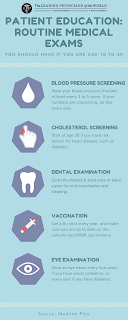Searching for Health Guidance
A
2015 Pew Research Center Study reveals that "73% of all those
ages 16 and over say libraries contribute to people finding the health
information they need. 42% of those who have gone online at a library using its
computers, internet connections or Wi-Fi have done so for health-related
searches." In 2013, the Pew Research Internet Project reported
that "59% of U.S. adults say they have looked online
for information about a range of health topics in the past year. 35% of
U.S. adults say they have gone online specifically to try to figure out what
medical condition they or someone else might have." Whether the health
information is needed for personal reasons or for a loved one, millions of
health-related web pages are viewed by millions of consumers. Sometimes the
information found is just what was needed. Other searches end in frustration or
retrieval of inaccurate, even dangerous, information.
As many
people have discovered, clicking on a favorite search engine and entering a disease
or medical condition can often result in thousands, even millions, of
"hits." This can be discouraging. Here are a few ideas for filtering
the available web pages to a manageable number:
●If you are
using a search engine such as Google or Bing, take advantage of the advanced
searching features of the sites so that you can combine terms to make your
retrieval more precise. For example, entering the term "cancer" and
"chemotherapy" linked together is more powerful and precise than
trying to read through all the hits found by simply entering the general term
"cancer."
●Become
familiar with the general health information finding tools such as MedlinePlus(http://www.nlm.nih.gov/medlineplus/),
produced by the National Library of Medicine, or Healthfinder® (http://www.healthfinder.gov)
from the US Department of Health and Human Services, which can get you started
by pointing you to good, credible health information quickly. The Medical
Library Association's "Top Health Websites" is another device to help
you start your search with a highly selective list of quality consumer health
information sites trusted by medical librarians.
●When you
have found sites that look relevant, use the guidelines below to help you
decide whether the information is as credible, timely, and useful as it
looks.
How often is the site updated?
The site
should be updated frequently. Health information changes constantly as new
information is learned about diseases and treatments through research and
patient care. websites should reflect the most up-to-date information.
The website
should be consistently available, with the date of the latest revision clearly
posted. This usually appears at the bottom of the page.
Does the site present facts and not
opinion?
Information
should be presented in a clear manner. It should be factual (not opinion) and
capable of being verified from a primary information source such as the
professional literature, abstracts, or links to other websites.
Information
represented as an opinion should be clearly stated and the source should be
identified as a qualified professional or organization.
Who is the intended audience?
The website
should clearly state whether the information is intended for the consumer or
the health professional.Many health information websites have two different
areas - one for consumers, one for professionals. The design of the site should
make selection of one area over the other clear to the user.
Doctors
remain the most trusted source of medical information, trusted by 95% of
consumers. However, consumers are increasingly leveraging online resources to
both prepare for appointments and validate physician recommendations – moving
beyond diagnosis to become more active in the treatment decision.




Comments
Post a Comment